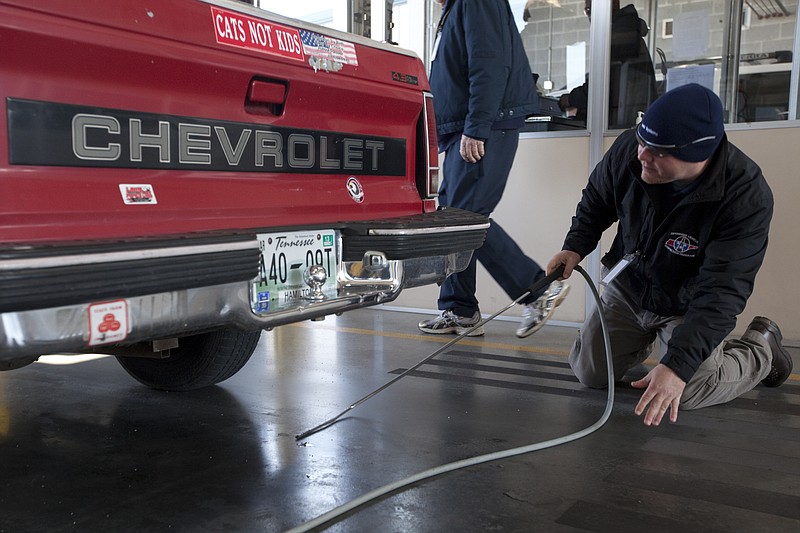NASHVILLE - Tennessee environmental officials hope to argue to the federal government that the state can safely end mandatory vehicle emissions inspection requirements in Hamilton and four mid-state counties, saying a monthslong study shows doing so won't significantly increase current ozone levels in the air.
In an update to the 2018 inspection-repeal law passed by Rep. Mike Carter, R-Ooltewah, and Sen. Bo Watson, R-Hixson, the Tennessee Department of Environment and Conservation says the agency's draft technical modeling shows ending the required Inspection and Maintenance, or I/M, program only "results in a small increase in ozone in both Hamilton County and Middle Tennessee.
"The increase is not projected [to] put either location above the [National Ambient Air Quality Standards]," TDEC stated.
As a result, the agency said, the state's Division of Air Pollution Control "will recommend elimination of the I/M program with no offsets or substitute measures required to maintain air quality." That recommendation will go to the U.S. Environmental Protection Agency, a process expected to take a year.
"That's an enormous victory," Carter said Friday as he and Watson both hailed the news.
Alluding to skeptics, Watson quipped, "we've been trying to tell everyone it was good."
Carter said he believes the state requirements will be completed "and the request for termination of the program will be submitted to EPA in the spring of 2020."
But the lawmakers also emphasized there are months of legal and procedural work ahead.
"I feel cautiously optimistic that we're going to get this thing done with the feds," Watson said. "There's just a process, and it takes longer than anyone would like."
The lawmakers brought the legislation in response to local vehicle owners who complained about the costs of compliance, not so much the $9 annual inspection fee, but expenses running into hundreds or even thousands of dollars to repair or replace car or truck catalytic converters and other equipment that could cause a vehicle to fail inspection.
Those costs hit low-income families and start-up businesses especially, the lawmakers said.
A number of steps are still required at the state level before Tennessee officials submit a proposed technical demonstration to EPA for review.
For example, after Gov. Bill Lee's office signed off recently on the proposed draft rule change, the next step is a 30-day informal interagency review between TDEC and EPA.
Feedback and further consultation with local agencies could prompt changes. The hope is to brief the state's Air Pollution Control Board sometime in August. Later steps include public notice for meetings before the board could take action.
The EPA review of the state's modeling and final action could take a year. And even after that there would be a 120-day wait at the state level before the programs are eliminated.
Bob Colby, director of the Chattanooga-Hamilton County Air Pollution Control Bureau, has been keeping up with the process.
"It's all up to EPA," Colby said. "And you know, assuming the state has done a good job in the inputs and running the model which it's intended to do, I don't think there should be a problem."
If the modeling is accurate, "there would be a negligible impact" on local air quality, Colby said.
According to TDEC, the current federal ozone standard is no more than 70 parts per billion.
What they found was Chattanooga's ozone value is now 66 parts per billion.
Eliminating vehicle inspections, which are designed to detect ozone pollution from malfunctioning car and truck emissions systems, would increase the ozone particles by only .209 parts per billion, well below the 70 parts per billion standard, according to TDEC's examination of air quality and traffic.
For Middle Tennessee, the current parts per billion is allowed is 67. Doing away with the inspection programs would lead to a .259 ppb increase, according to TDEC, again below the 70 ppb standards.
Middle Tennessee counties impacted are Rutherford, Sumner, Williamson and Wilson counties. Like Hamilton, all have the inspection and maintenance programs under an EPA-approved State Implementation Plan.
Davidson County officials asked to be left out of the 2018 law, Carter said.
But there are months to go.
"I know people are frustrated with that," said Watson, noting he speaks from personal experience. "I just took my Jeep to emissions testing a little over a week ago."
Scott Banbury with the Sierra Club's Tennessee chapter voiced some reservations, noting Tennessee and Chattanooga in particular have "made huge gains in air quality, partially because of required testing."
Without the mandatory testing, he asked, "what is going to ensure people keep up" with vehicle maintenance?
Colby said he thinks that will be "probably inconsequential." He noted that in Hamilton County, some vehicle owners are already getting their vehicles registered in nearby counties like Bradley and Sequatchie to evade testing, keeping their fingers crossed they won't get stopped by police for a driving infraction and getting questioned about discrepancies between their vehicle registration and driver license home addresses.
"As has been said from the beginning, this is all up to EPA," Colby said. "The state has so far come up with some pretty convincing evidence it may no longer be needed here. But it's up to EPA."
And the federal agency "is certainly not going to allow backsliding," Colby said. "We'll just have to wait and see what happens."
Regardless, Colby said, the city's made huge strides in the last half century from when Chattanooga was considered one of the nation's dirtiest cities, although many of the factories producing pollution no longer exist.
"It's cleaner than it's ever been is the truth of the matter," Colby said. "And that's something everybody should be proud of, especially here in Chattanooga. Because we came from a bad place and we're in a good place right now."
Contact Andy Sher at asher@timesfreepress.com or 615-255-0550.


